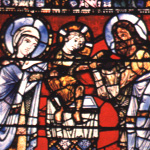
Medieval Europe

Medieval Proofs for the Existence of God
Selections from Aquinas' Summa Theologica:
On War
On Killing
On Cheating with Regard to Buying and Selling
On Usury
On Lying
On Drunkenness
On Lust
Literature and the Middle Time
Important Dates in Medieval History Quiz
. . .
In history texts, medieval European history often goes by its older soubriquet, the Middle Ages. Typically, the period stretches from the collapse of IMPERIAL ROME to the coming together of the forces of the RENAISSANCE in Europe. It was the intelligentsia of the Renaissance that labelled the years preceding their own as middle -- caught between the ethos of the archaic civilizations Greece and Rome and the revitalized learning of their own time. That the thinkers of the Renaissance were masters of hubris is not news; their less-than-generous characterization of the thousand or so years that separated them from Rome reflects their prejudices and their collective oversight.
For the Middle Ages were much less uniform and much richer than most Renaissance thinkers would allow. MICHELANGELO could sculpt a muscular David alive and full of motion though cut from stone; but it was a magnificent communal enterprise that designed and executed CHARTRES CATHEDRAL in the center of a sleepy town southwest of Paris some 800 years ago. The cathedral stands today as a symbol (for even such a cultural cynic as Henry Adams) of the extraordinary integration of religion and political life that characterizes the Chartres of the twelfth century and the Middle Ages in general. You can still see the spires of the cathedral rise out of the fields of grain as you approach on the train (no bullet train stops here), and the high-rise mentality of modern life is happily absent from the modern, burgeoning town, all of whose buildings bend low as if in homage to the heaven-reaching church. Then there was no division of Church and State: the Church became the State, and the city wore its cathedral like a holy badge of Christendom on earth.
DANTE ALIGHIERI was born a century after the completion of Chartres. His city-home Florence was racked with political struggle, and Dante had to flee. Exile from city life gave the writer time to create The Divine Comedy, an epic account of the poet's journey through purgatory and hell to heaven. And as can be seen in Chartres, the connection for Dante between the miry political world on earth and the spiritual world of after-life is clear: in The Inferno, the poet encounters those who have sinned on earth -- politicians, liars, murderers, even those great people from history whose only misfortune was to have been born before Christ. His great work reifies the medieval integration of the religious and the social. [Next]
Home | Near East | India | Egypt | China | Greece | Rome | Islam | Europe | Conclusions
Computer Services Provided by the University of Evansville.
Copyright © 1997. Exploring Ancient World Cultures.